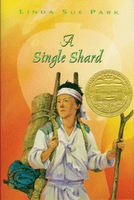A SINGLE SHARD
 BIBLIOGRAPHY
BIBLIOGRAPHYPark, Linda Sue. 2002. A SINGLE SHARD. Read by Graeme Malcolm. New York: Listening Library ISBN: 0-8072-0701-2 Reading level: age 10 -14
PLOT SUMMARY
Background on the 12th Century Korea, this story is about an orphan named Tree Ear. He lived under a bridge with a crane man who was physically disabled. Their village, Ch’ulp’o was famous for celadon, and there was a master potter, Min. After watching Min working, Tree Ear was fascinated about making pottery, and had a dream of making his own celadon someday. One day, Tree Ear accidentally broke one of Min's pieces, and Min witnessed it. To compensate this damage, Tree Ear had to work for Min. An emissary named Kim visited the village to order a commission for the royal court. Min couldn’t finish his work before Kim leaves Ch’ulp’o, so Tree Ear had to take two vases to the Son-do, capital. On his way, Tree Ear met robbers and the vases were broken. Tree Ear was in despair, but he decided to bring one single shard to Kim. Fearing rejection, Tree Ear met Kim and showed him the single shard. Surprisingly, Kim said, “I say it of this one. And the inlay work…remarkable, I am assigning him a commission.” When Tree Ear returned to Min’s, he heard that his sincere friend crane man had died in an accident. His sorrow was so deep that Tree Ear couldn’t do anything, but Min insisted that Tree Ear continue his work. Eventually, Min’s family decided to adopt Tree Ear as their son and gave him a new name, Hyung-pil. The name shared a syllable with Min’s late son, Hyung-gu. Finally, Tree Ear’s dream had come true.
CRITICAL ANALYSIS
As a Newbery Award winning book, the author tried to incorporate her understanding of the Koryo era and celadon pottery into the book. This unabridged cassette format has three tapes, and is read by Graeme Malcolm. Although he tried to keep an exact pronunciation of some Korean words such as ‘jiggeh’ and ‘Ajima,’ and change tones in conversation parts, the rate of his reading is somewhat fast. In addition, there are no sound effects during the reading except the first and closing parts started with Korean traditional music including a ‘Gayageum’ which is a twelve-stringed Korean harp. Compared with the book, I recognized the audio book needs to be more focused on reading. The quality of these cassettes was not good so I had to stop and go back to the part I couldn’t understand. However, as a Korean, I was really impressed with Linda’s explanation of Koryo celadon pottery and information about life and society in Korea during the Koryo era. This book is an impressive story of an orphan boy who overcame his adversities to become a great potter. This book is a great source to introduce Korean culture and history to children.
REVIEW EXCERPTS
Publishers Weekly (March 10, 2003)
In a starred review of this Newbery Medal winner, PW wrote, "The author molds a moving tribute to perseverance and creativity in this finely etched novel set in mid- to late-12th-century Korea. Readers will not soon forget these characters or their sacrifices." Ages 10-up. (Feb.) Copyright 2003 Reed Business Information.
Horn Book Guide (October 1, 2001)
Tree-ear, a twelfth-century Korean boy, wants desperately to become a potter of celadon ware like the revered and talented potter Min. Though homeless and orphaned, Tree-ear wins the approval of Min, eventually becoming an indispensable apprentice to him. While the characters are somewhat flat and the plot slow, Park's story is alive with fascinating information about life and art in ancient Korea. Copyright 2001 of The Horn Book, Inc. All rights reserved.
CONNECTIONS
*Online Quiz after reading ‘A Single Shard’
http://school.discovery.com/quizzes21/lspark/Shard.html
*Internet resources about celadon pottery
The Metropolitan Museum of Art
www.metmuseum.org/explore/korea/gallery.html
KoreaInfogate
www.koreainfogate.com/beautykorea/special/celadon.asp
*Additional reading lists
Whelan, Gloria. Homeless Bird. ISBN: 0-7862-4060-1
Park, Linda Sue. The Kite Fighters. ISBN: 0-440-41813-5
McCaughrean, Gerald. The Kite Rider. ISBN: 0-06-441091-9
Choi, Sook Nyul. Year of Impossible Goodbyes. ISBN: 0-8335-9794-9


